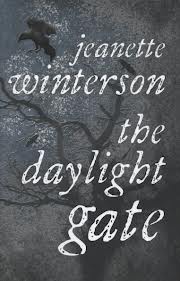Jeanette Winterson, The Daylight Gate. London: Arrow, 2012.
Acclaimed English novelist Jeanette Winterson’s latest book is something of a curiousity.
The book has been published by Arrow in partnership with famed British horror film studio Hammer, who have commissioned a series of horror novellas which according to the back cover spiel “will span the literary and the market, the esoteric and the commercial, by some of today’s most celebrated authors.”
And so, gamely taking on a new genre after eleven novels of more-or-less magical realism, Winterson in The Daylight Gate has taken a turn towards early modern horror in setting the novel during the witch trials of England under King James in the early 1600s. “It’s grim up north” as the saying goes, and Winterson seems to be working roughly with the same vein as the similarly chilly popular Game of Thrones fantasy television series, with unrelenting misery, torture and rape featuring throughout.
The Daylight Gate has a little of the lush prose with which Winterson has made her name; the romances between Alice and Elizabeth and Alice and Christopher inject a little tenderness into this grim tale. Winterson’s work has always had its gruesome elements (the pair of framed human hands in The Passion, for instance) and here it has taken centre stage.
The story of The Daylight Gate is that of Alice Nutter, a self-made woman who made her fortune by inventing a magenta dye favoured by Queen Elizabeth. Nutter attempts to use her position protect a family accused of witchcraft.
Perhaps inevitably, Shakespeare makes a cameo appearance to mutter sagely about the abrupt shift in the English religious imagination from Catholicism to Protestantism. Intertexts to A Winter’s Tale and The Tempest appear to link the magic of witchcraft to the magic of narrative (a longstanding preoccupation of Winterson’s). There is no textual hesitation as to whether the witches’ magic is real, though, it is entirely real. This introduces an interesting ambivalence in the story, a “yes, but” defense – the witches are being correctly accused of witchcraft, and yet are culturally disempowered and violently scapegoated.
So though she’s taken on the horror genre, there are distinct signs that Winterson has other ambitions beyond simply scaring her audience, reflecting instead on state power, the misogyny of the witch-hunt, and narrative itself. The Daylight Gate shows the political entanglement of witch-hunting with Catholic hunting under King James, “a man who had two passions: to rid his new-crowned country of popery and witchcraft.”
Though there are supernatural elements – Alice’s lover Elizabeth has sold her soul to the Devil – Winterson finds the true horror to be those of human history: “Only human beings can know what it means to strip a human being of being human” (83). Given the grim history of witch trials, not to mention all the other human-made horrors of the last four centuries, this perspective seems fitting.
There is nothing wrong with a writer taking on a new genre, or working with some externally imposed limitation – both can produce masterworks. But as good a writer as Winterson is, The Daylight Gate in the end feels a little forced, awkwardly teetering between horror and historical romance. A minor work by a major writer.

